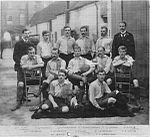Sir William Borlase's Grammar School
1624 establishments in EnglandAcademies in BuckinghamshireEducational institutions established in the 1620sGrade II* listed buildings in BuckinghamshireGrammar schools in Buckinghamshire ... and 3 more
Marlow, BuckinghamshireUse British English from February 2023Vague or ambiguous time from August 2019
Sir William Borlase's Grammar School (commonly shortened to Borlase or SWBGS) is a selective state grammar school accepting pupils of all genders aged 11–18 located in Marlow, Buckinghamshire, England. It is situated on West Street, close to the town centre and also accepts students from nearby towns. It has around 1000 pupils, including a sixth form of about 380.
Excerpt from the Wikipedia article Sir William Borlase's Grammar School (License: CC BY-SA 3.0, Authors).Sir William Borlase's Grammar School
West Street,
Geographical coordinates (GPS) Address Phone number Website External links Nearby Places Show on map
Geographical coordinates (GPS)
| Latitude | Longitude |
|---|---|
| N 51.57021 ° | E -0.78163 ° |
Address
Sir William Borlase's Grammar School
West Street
SL7 2BR
England, United Kingdom
Open on Google Maps










